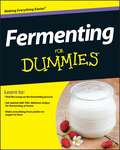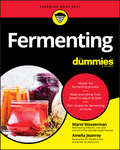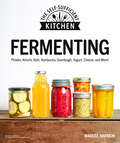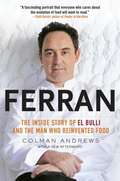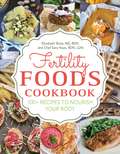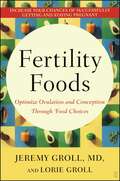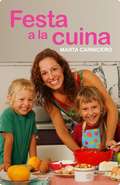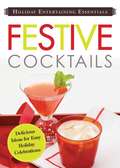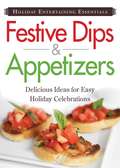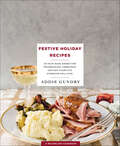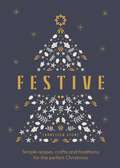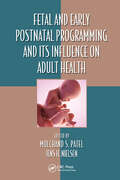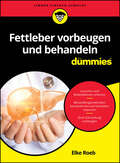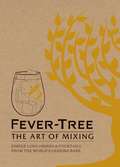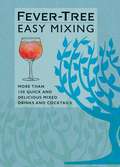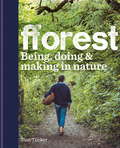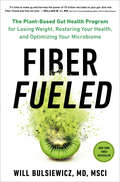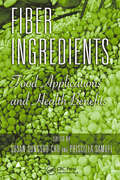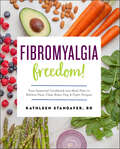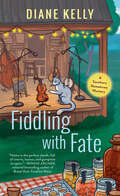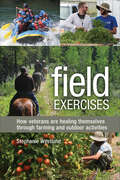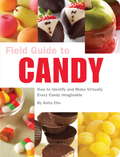- Table View
- List View
Fermenting For Dummies
by Amelia Jeanroy Marni WassermanWant to ferment at home? Easy.Fermentation is what makes foods like beer, pickles, and sauerkraut delicious--and nutritious. Fermented foods are chock-full of probiotics that aid in digestive and overall health. In addition, the fermentation process also has been shown to add nutrients to food, making already nutritious food even better! Fermenting For Dummies provides step-by-step information for cooks, homesteaders, farmers, and food lovers of any kind who want to develop a deeper understanding and appreciation for arguably the oldest form of food preservation.Fermenting For Dummies gives you the scoop on the fermenting process, the tools and ingredients you'll need to get started, and 100+ recipes for fermenting at home. So what are you waiting for?Shows you how to ferment vegetables, including slaw-style, pickles, and kimcheeCovers how to ferment dairy into yogurt, kefir, cheese, and butterExplains how to ferment fruits, from lemons to tomatoes, and how to serve themDetails how to ferment beverages, including mead, beer, kombucha, vinegar, and moreIf you're interested in preserving food using this ancient method, Fermenting For Dummies has everything you need to get started.
Fermenting For Dummies
by Amelia Jeanroy Marni WassermanFermenting For Dummies (9781119594208) was previously published as Fermenting For Dummies (9781118615683). While this version features a new Dummies cover and design, the content is the same as the prior release and should not be considered a new or updated product.Want to ferment at home? Easy. Fermentation is what makes foods like beer, pickles, and sauerkraut delicious—and nutritious. Fermented foods are chock-full of probiotics that aid in digestive and overall health. In addition, the fermentation process also has been shown to add nutrients to food, making already nutritious food even better! Fermenting For Dummies provides step-by-step information for cooks, homesteaders, farmers, and food lovers of any kind who want to develop a deeper understanding and appreciation for arguably the oldest form of food preservation. Fermenting For Dummies gives you the scoop on the fermenting process, the tools and ingredients you’ll need to get started, and 100+ recipes for fermenting at home. So what are you waiting for? Shows you how to ferment vegetables, including slaw-style, pickles, and kimchee Covers how to ferment dairy into yogurt, kefir, cheese, and butter Explains how to ferment fruits, from lemons to tomatoes, and how to serve them Details how to ferment beverages, including mead, beer, kombucha, vinegar, and more If you're interested in preserving food using this ancient method, Fermenting For Dummies has everything you need to get started.
Fermenting: Pickles, Kimchi, Kefir, Kombucha, Sourdough, Yogurt, Cheese and More! (The Self-Sufficient Kitchen)
by Wardeh HarmonEverything you need to master the age-old art of fermentation from home!From kombucha and kefir to sourdough and kimchi, this cookbook is your go-to guide for safe fermentation and discovering the science of probiotic foods.This newly revised edition covers the amazing health benefits of fermented foods and the techniques for safely fermenting food at home. It includes: • More than 100 recipes for ferments of all types, including beverages, cultured dairy, fermented grains, vegetable ferments, and much more • Helpful insights on the tools and techniques you'll need to know to safely create nearly any type of fermented food • Expert guidance from Wardeh Harmon on how fermentation works, how to troubleshoot common fermentation issues, and how to grow your own starters Fermented foods are currently experiencing a renaissance. People are discovering not only the health benefits of live-culture foods but also the true pleasure of creating their own fermentations at home. The diverse chapters in this recipe book cover everything from the history of fermentation to common fermentation recipes for vegetables, fruits, grains, and even alcoholic beverages. This authoritative guide features a wide range of DIY fermentation projects that allow you to progress from simple fermented condiments like chutneys and mayonnaise to more advanced techniques such as fermenting meats and fish. Fermenting will give you all the tools you need to start making your own delicious cultured food right away and help you ease into this exciting hobby! It&’s the perfect book for anyone who has thought about trying to ferment their own food.
Ferran: The Inside Story of El Bulli and The Man Who Reinvented Food
by Colman AndrewsMore than just the most influential chef of the late- twentieth and early-twenty-first centuries, Ferran Adrià is arguably the greatest culinary revolutionary of our time. Hailed as a genius and a prophet by fellow chefs, worshipped (if often misunderstood) by critics and lay diners alike, Adrià is imitated and paid homage to in professional kitchens, and in more than a few private ones, all over the world. A reservation at his restaurant, El Bulli, is so coveted that scoring a table is harder than nabbing fifty-yard-line tickets for the Super Bowl. In his lively, and unprecedented, close-up portrait of Adrià, award-winning food writer Colman Andrews traces this groundbreaking chef's rise from resort hotel dishwasher to culinary deity, and the evolution of El Bulli from a German-owned beach bar into the establishment voted annually by an international jury to be "the world's best restaurant. " Taking the listener from Adrià's Franco-era childhood near Barcelona through El Bulli's wildly creative "disco-beach" days and into the modern-day wonderland of Adrià's restaurant kitchen and the workshop/laboratory where his innovations are born and refined, Andrews blends sweeping storytelling with culinary history to explore Adrià's extraordinary contributions to the way we eat. Through original techniques like deconstruction, spherification, and the creation of culinary foams and airs, Adrià has profoundly reimagined the basic characteristics of food's forms, while celebrating and intensifying the natural flavors of his raw materials. Yet, argues Andrews, these innovations may not be his most impressive achievements. Instead, Adrià's sheer creativity and courageous imagination are his true genius-a genius that transcends the chef's métier and can inspire and enlighten all of us. Early in 2010, Ferran stunned the food world by announcing that he plans to close El Bulli at the end of the 2011 season for a two-year hiatus. Chefs, critics, and food-lovers everywhere are asking what that means for this legendary chef and his groundbreaking restaurant. Andrews reveals the inside story, from Ferran himself. Entertaining and intimate, Ferran brings to life the most exciting food movement of our time and illuminates the ways in which Adrià has changed our world-forever altering our understanding of and appreciation for food and cooking.
Fertility Foods: 100+ Recipes to Nourish Your Body While Trying to Conceive
by Elizabeth Shaw Sonali Ruder Sara HaasA complete dietary program for women seeking healthy pregnancy. Created by RDN certified experts, Fertility Foods provides you with powerful nutritional benefits and more than 100 recipes.Struggling with infertility can be one of the most frustrating experiences for women looking to conceive. Rather than juggle multiple prescription medications all while scheduling an endless series of doctors’ visits, Fertility Foods helps you to seek better results—just by changing your diet! As you prepare to enter one of the most significant times in your life, you owe it to yourself and your future children to make sure that your body has absolutely everything it needs, at the proper times and in the proper quantities. Fertility Foods includes: · Over 100 nutritious, satisfying dishes to boost your fertility · Dietary breakdowns to help you understand what will help your body conceive, and why · Tips on managing stress and other lifestyle factors · Heartfelt support and guidance from women who have struggled with infertility · A how-to guide on putting together a healthy kitchenFertility Foods is more than just a diet plan or cookbook. It’s a companion, a constant support providing you with the information you need to ensure you receive proper nutrition before conception.
Fertility Foods: Optimize Ovulation and Conception Through Food Choices
by Jeremy Groll Lorie GrollDr. Jeremy Groll is an expert in reproductive endocrinology and fertility treatment. Fertility Foods presents his groundbreaking, noninvasive, nutritionally based method, which increases ovulation, reduces miscarriage, and significantly improves your chances of successfully getting and staying pregnant. Dr. Groll's specialized research has proven that there is a powerful link between a body's insulin resistance and fertility problems. Resistance to insulin increases the body's insulin levels, hindering normal ovulation either by limiting the maturation process of the released egg or by preventing ovulation altogether. High insulin levels can also impede the fertilized egg's ability to attach to the uterus, leading to implantation failure and miscarriage. In fact, women with insulin resistance problems are four to five times as likely as other women to suffer miscarriages -- meaning they have as high as a 50 percent chance of miscarriage. Dr. Groll has developed an insulin-reducing diet based on balancing protein and complex carbohydrate intake to create insulin levels most conducive to ovulation. He combines his nutritional plan -- which includes nutritional charts, food suggestions, and recipes -- with a specific exercise program that enhances insulin metabolism and an emotional support system that you can draw on during your quest to become parents. This three-pronged approach increases the rates of spontaneous ovulation and significantly improves the uterine environment, decreasing the potential for miscarriage. One in every ten couples in America is affected by infertility. Yet, only 5 to 10 percent of patients actually need high-tech procedures such as in vitro fertilization. Whether you are taking your first steps in combating infertility or searching for effective methods to support more advanced fertility treatments, Fertility Foods is your helpful and rewarding guide.
Fertility, Cycles and Nutrition
by Marilyn M. ShannonHow your diet affects your menstrual cycles and fertility.
Festa a la cuina
by Marta CarniceroCuinar és molt divertit i així és com ho hem de comunicar als més petits de la casa. A la cuina, els nens hi aprenen moltes coses, es fan més autònoms, guanyen autoestima, satreveixen a tastar nous aliments i, a més, sentretenen.Festa a la cuina és un complet llibre de receptes a lestil tradicional dirigit tant als més petits com als nois que ja poden fer els primers passos culinaris tots sols. Els plats que presenta són fàcils delaborar, sans i molt apropiats per als gustos infantils i de tota la família.Amb el llibre a la mà podreu preparar dolços per animar una tarda de pluja, llaminadures per a una festa, batuts fresquets per lestiu, àpats ràpids per quan teniu molta pressa, plats freds per quan tornem de la platja, pizzes per a una nit de dissabte, plats per un sopar de cada dia, menús per sorprendre als pares. I un munt didees delicioses a les quals ningú no es podrà resistir.
Festive Cocktails: Delicious ideas for easy holiday celebrations (Holiday Entertaining Essentials)
by Adams MediaLooking for something new to serve up during the holidays? Look no further! Holiday Entertaining Essentials: Festive Cocktails is a delicious selection of tasty drinks that’ll make your celebrations even merrier. From Gingerbread Hot Toddies to Holly Berry Cocktails, these festive concoctions will really get things rocking around the Christmas tree. Merry Christmas and enjoy!
Festive Dips and Appetizers: Delicious ideas for easy holiday celebrations (Holiday Entertaining Essentials)
by Adams MediaLooking for something new to serve up during the holidays? Look no further! Holiday Entertaining Essentials: Dips and Appetizers is a delicious selection of tasty party favorites that’ll make your celebrations even merrier. From Layered Shrimp and Pesto Dip to Vegetable Empanadas, these festive dishes will really get things rocking around the Christmas tree. Merry Christmas and enjoy!
Festive Holiday Recipes: 103 Must-Make Dishes for Thanksgiving, Christmas, and New Year's Eve Everyone Will Love (RecipeLion)
by Addie GundryIn Festive Holiday Recipes, Food Network star Addie Gundry offers easy, delightful holiday recipes all in one place for everyone looking for that last minute recipe for entertaining. There’s a reason it’s called the most wonderful time of the year. From easy appetizers for holiday and New Year’s Eve entertaining, like Caramelized Onion Tartlets, to recipes for The Best Roast Turkey and all your favorite sides, pies, and even leftover ideas, this book is a home cook’s trusty sous chef for easy and elegant entertaining throughout the holiday season. Three words to remember: Salted Caramel Eggnog. Each recipe is paired with a four-color, full-bleed photo.Recipe Lion is part of Prime Publishing LLC, a lifestyle multi-platform brand focused on cooking and crafting content. The Prime group receives over 68 million monthly page views, and over 7.9 million readers subscribe to Prime’s family of email newsletters. Prime has leveraged their extensive user base, search data, and SEO expertise to choose topics and recipes for the cookbook series.
Festive: Simple recipes, crafts and traditions for the perfect Christmas
by Francesca StoneMake Christmas magicIn this book, you'll find easy, accessible ways to embrace your festive spirit and create lasting memories with the family with a collection of traditions - old and new - including simple recipes, styling tips and crafts to make your celebrations meaningful and beautiful without the big spend.By using traditional, low-cost ingredients to create simple and tasty festive recipes and foraging, recycling, and using inexpensive items from around your home for cosy styling and beautiful crafts to keep or give as gifts, you can have a perfect, budget-friendly and more sustainable Christmas.Recipes will include Mini gingerbread house biscuits, Brie and cranberry waffles, Christmas Cake and Mince pies, with styling tips covering how to dress your front door, tree and shelves, and crafts ranging from honeycomb paper trees to creating needle felted ornaments, recycled wax candles and natural beaded garlands.This is a book you'll reach for year on year.
Fetal and Early Postnatal Programming and its Influence on Adult Health (Oxidative Stress and Disease)
by Mulchand S. Patel Jens H. NielsenThere is a documented link between fetal nutrition and the development of disease risk in adult life. Including the early postnatal period, during which a newborn continues to grow rapidly influenced by environmental factors, suggests that individuals are subject to risks for more than just the fetal period. Fetal and Early Postnatal Programming and its Influence on Adult Health focuses on interrelated aspects of cellular programming related to early nutrition and this potential global health problem.
Fettleber vorbeugen und behandeln für Dummies (Für Dummies)
by Elke RoebEin Buch für mehr Lebergesundheit Leiden Sie an einer Fettleber oder hat Ihnen Ihr Arzt gesagt, Sie sollten Ihr Verhalten umstellen, da sich sonst eine entwickeln könnte? Da kann Ihnen dieses Buch helfen. Elke Roeb erklärt Ihnen verständlich, was eine Fettleber ist und wie sie entsteht. Unaufdringlich gibt die Autorin Ihnen Ratschläge, was Sie gegen eine Fettleber machen können oder wie Sie deren Entwicklung vermeiden. Sie stellt Lebensmittel vor, die Sie meiden sollten, und auch solche, die Ihnen helfen. Daneben erklärt sie, welche medizinischen Behandlungsmöglichkeiten es gibt und vieles mehr. Sie erfahren Welche Funktion Ihre Leber hat und wie sie aufgebaut ist Welche Ursachen und Risikofaktoren es gibt Wie Fettleber, Leberfibrose und -zirrhose zusammenhängen Welche Maßnahmen, Medikamente und Operationen helfen können
Fever Tree - The Art of Mixing: Simple long drinks & cocktails from the world's leading bars
by FeverTree Limited'The Ultimate G&T' -- Jamie Oliver'The best tonic on the planet' -- Ashton KutcherThe first cocktail book to put the mixers centre-stage, from brilliant Fever-Tree brand and created by leading bartenders around the world.Rather than starting with the spirits, this book focuses on key mixers - including tonic, lemonade, ginger ale, ginger beer and cola. Leading bartenders have created 125 classic and contemporary cocktail recipes that make the most of the botanical partnerships.The book also explores the origins of key ingredients, including quinine, lemons and elderflower, revealing the role quinine has played in geo-politics, for example, and the impact different herbs have on taste. In the way that we increasingly want to know the source and production methods of the food we eat, so this guide allows you to understand more fully what we drink - and use that knowledge to create the most delicious cocktails.
Fever Tree - The Art of Mixing: The Art Of Mixing - Simple Long Drinks And Cocktails From The World's Leading Bars
by Fever-Tree Limited'The Ultimate G&T' -- Jamie Oliver'The best tonic on the planet' -- Ashton KutcherThe first cocktail book to put the mixers centre-stage, from brilliant Fever-Tree brand and created by leading bartenders around the world.Rather than starting with the spirits, this book focuses on key mixers - including tonic, lemonade, ginger ale, ginger beer and cola. Leading bartenders have created 125 classic and contemporary cocktail recipes that make the most of the botanical partnerships.The book also explores the origins of key ingredients, including quinine, lemons and elderflower, revealing the role quinine has played in geo-politics, for example, and the impact different herbs have on taste. In the way that we increasingly want to know the source and production methods of the food we eat, so this guide allows you to understand more fully what we drink - and use that knowledge to create the most delicious cocktails.
Fever-Tree Easy Mixing: More than 150 Quick and Delicious Mixed Drinks and Cocktails
by FeverTree LimitedFrom the world's leading premium mixer brand, Fever-Tree Easy Mixing: More than 150 Quick and Delicious Mixed Drinks and Cocktails, is Fever-Tree's follow up to the bestselling Art of Mixing. With clever variations on the classic gin and tonic to a selection of spritzes, mules and mojitos, to some nifty no-and-low alcohol alternatives and a handful of pitchers for when the party really gets started, Fever-Tree Easy Mixing celebrates how easy it is for anyone to enjoy quick and delicious drinks at home.
Fever-Tree Easy Mixing: More than 150 Quick and Delicious Mixed Drinks and Cocktails
by FeverTree Limited***'Thanks, Fever-Tree for de-mystifying the whole mixing business and making us all Cocktail Masters. There's no excuse now: here's the secret to great, refreshing, stylish serves first time, every time!'Ian Buxton, author Gin: The Ultimate Companion.From the world's leading premium mixer brand, Fever-Tree Easy Mixing: More than 150 Quick and Delicious Mixed Drinks and Cocktails, is Fever-Tree's follow up to the bestselling Art of Mixing. With clever variations on the classic gin and tonic to a selection of spritzes, mules and mojitos, to some nifty no-and-low alcohol alternatives and a handful of pitchers for when the party really gets started, Fever-Tree Easy Mixing celebrates how easy it is for anyone to enjoy quick and delicious drinks at home.
Fforest: Being, Doing & Making in Nature
by Sian TuckerCalming to the soul and good for us all, spending time outdoors offers us precious breathing space away from the stresses and strains of modern life. This inspirational guide celebrates the life enhancing effect of nature and encourages you to try the pursuits that would have been second nature to previous generations - from walking in the dark with only the light of the moon and stars to guide you, to wild swimming, forest bathing and sleeping under canvas. It will inspire you to re-discover the joy of sky and clouds, night and tides, stars and silence. <P><P>Photography by Finn Beales
Fiber Fueled: The Plant-Based Gut Health Program for Losing Weight, Restoring Your Health, and Optimizing Your Microbiome
by Will BulsiewiczA bold new plant-based plan that challenges popular keto and paleo diets, from an award-winning gastroenterologist.The benefits of restrictive diets like paleo and keto have been touted for more than a decade, but as renowned gastroenterologist Dr. Will Bulsiewicz, or "Dr. B," illuminates in this groundbreaking book, the explosion of studies on the microbiome makes it abundantly clear that elimination diets are in fact hazardous to our health. What studies clearly now show--and what Dr. B preaches with his patients--is that gut health is the key to boosting our metabolism, balancing our hormones, and taming the inflammation that causes a host of diseases. And the scientifically proven way to fuel our guts is with dietary fiber from an abundant variety of colorful plants.Forget about the fiber your grandmother used to take--the cutting-edge science on fiber is incredibly exciting. As Dr. B explains, fiber energizes our gut microbes to create powerhouse postbiotics called short-chain fatty acids (SCFAs) that are essential to our health. SCFAs are scientifically proven to promote weight loss, repair leaky gut, strengthen the microbiome, optimize the immune system, reduce food sensitivities, lower cholesterol, reverse type 2 diabetes, improve brain function, and even prevent cancer. Restrictive fad diets starve the gut of the critical fiber we need, weaken the microbes, and make our system vulnerable.As a former junk-food junkie, Dr. B knows firsthand the power of fiber to dramatically transform our health. The good news is that our guts can be trained. Fiber-rich, real foods--with fruits, vegetables, whole grains, seeds, nuts, and legumes--start working quickly and maintain your long-term health, promote weight loss, and allow you to thrive and feel great from the inside out. With a 28-day jumpstart program with menus and more than 65 recipes, along with essential advice on food sensitivities, Fiber Fueled offers the blueprint to start turbocharging your gut for lifelong health today.
Fiber Ingredients: Food Applications and Health Benefits
by Susan Sungsoo Cho Priscilla SamuelThis book summarizes available fiber sources and how they can be incorporated into new food products to provide improved health benefits. It rigorously examines health claims, recent research, and contradictory data; covers fiber for weight and glycemic control, and intestinal regularity; and discusses how food producers can find fiber sources and
Fibromyalgia Freedom!: Your Essential Cookbook and Meal Plan to Relieve Pain, Clear Brain Fog, & Fight Fatigue
by Kathleen StandaferFight fibro the natural way—with food.There's a vital connection between what you eat and how you feel. Fibromyalgia Freedom! helps you manage your fibromyalgia naturally by taking control of your nutrition. This gourmet meal plan targets pain, lethargy, indigestion, and cognitive "brain fog," so you can find relief—and still eat well.The 4-stage plan starts you on a targeted diet, removing problematic foods to give your body a chance to heal. Over 110 recipes give you lots of engaging options to further reduce fibromyalgia symptoms. The recipes are brain- or immunity-boosting, and many are free of gluten, dairy, or allergens like nuts.In Fibromyalgia Freedom!, you'll find:4-week meal plan—Address fibromyalgia symptoms in four stages: Pain Management, Gaining Energy, Fighting Brain Fog, and Promoting Healthy Digestion.110+ nourishing recipes—Enjoy Thai Coconut Milk Soup, Crispy Baked Parsnip Fries, Italian-Style Meatballs, Creamy Chocolate Mousse, and more.Symptom tracking—Regain control of your health using a guided tracking strategy, made easy with charts for your symptoms, foods, and weekly progress.This holistic approach to fibromyalgia treatment will put you on the path to a more stress-free and symptom-free life.
Fiddling with Fate (A Southern Homebrew Mystery #3)
by Diane KellyWhen a local bluegrass musician disappears and a jug of her shop&’s corn liquor is implicated, moonshiner Hattie Hayes must stop further trouble from brewing in this delightful cozy mystery series.It&’s August in Chattanooga, Tennessee and moonshiner Hattie Hayes has collaborated with a nearby vineyard to serve her moonshine at a Wine and 'Shine event. Not only is this an opportunity for Hattie to gain more moonshine fans, but she&’s also excited to hear the Bootlegging Brothers, a popular bluegrass band. But not every attendee is looking for harmony. When one of the brothers disappears and is presumed dead, Hattie realizes her grace note gathering has suddenly turned more sour than her mash.Unearthing what happened to the missing musician is more difficult than Hattie first expected. Hattie&’s moonshine is tied to the crime and there&’s no time to fiddle around—she has to step up to solve the case. Luckily, Hattie&’s cool head and quick mind help her understand that when investigating a musical crime, always stay sharp.
Field Exercises: How Veterans Are Healing Themselves through Farming and Outdoor Activities
by Stephanie WestlundHow connecting with nature is helping veterans reintegrate into civilian life and recover from PTSD.There are nearly twenty-five million veterans and active-duty soldiers in North America. Some experts estimate that more than one quarter of these men and women suffer from post-traumatic distress, and many other military persons experience difficulty reintegrating into civilian life. While conventionally prescribed treatments primarily involve medication and therapy, many people are discovering additional ways to manage their injuries and reduce their suffering.Field Exercises: How Veterans Are Healing Themselves through Farming and Outdoor Activities shares the compelling stories of men and women who are finding relief from stressful and traumatic military experiences, while also establishing community networks and other peer support initiatives. Stephanie Westlund examines:The deep and far-reaching connections between nature and human healthThe tremendous impact of stress and trauma on survivors' livesResources and groups providing opportunities in the emerging field of “Green Care”.Field Exercises offers hope for veterans searching for methods to ease the transition to civilian life and recover from military stress and trauma. This book will appeal to millions of North American soldiers, veterans, and their loved ones, doctors, psychiatrists, social workers and other caregivers, other groups struggling with high rates of stress and post-traumatic experience, and all those interested in the relationship between nature and human health.Stephanie Westlund holds a PhD in peace and conflict studies. She has been conducting research with veterans since 2009, and continues to be inspired by their courage and personal resolve to move through pain toward recovery, and their unrelenting desire to serve their communities.
Field Guide to Candy
by Anita Chu Tucker HoslerAt last, a field guide to making and identifying virtually every candy imaginable, from peanut-butter cups to mint meltaways! Field Guide to Candy is the definitive guide to candies from around the world, with more than 100 recipes and variations on such tried-and-true classics as caramel apples, rocky road, and lollipops as well as traditional international favorites like Turkish delight, truffles, and French pralines. This delectable guide introduces readers to the best techniques for creating chocolates; sugary sweets; creamy, sticky, chewy candies; nutty treats; and fun and simple classics. Every candy is photographed in glorious full color, with step-by-step instructions on how to prepare, make, and store your creations. Entries include fascinating historical background, helpful baking notes, and serving suggestions for each delicious variety. Whether you're a candy-making novice or veteran pastry chef, mouth-watering homemade confections are minutes away with Field Guide to Candy!
